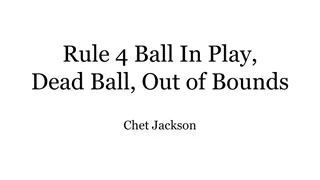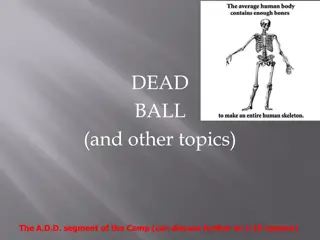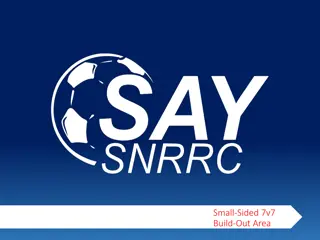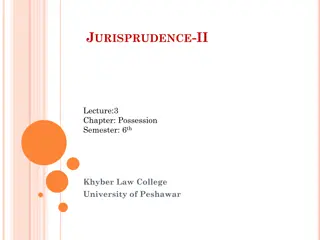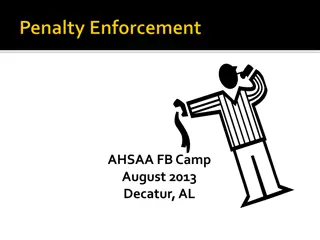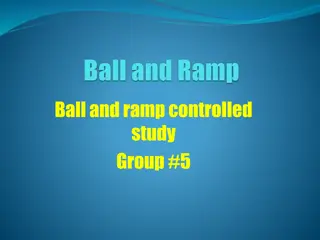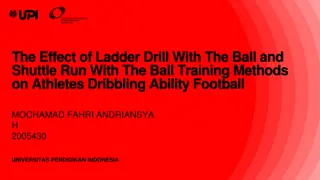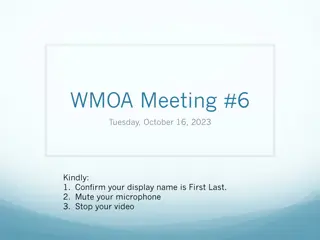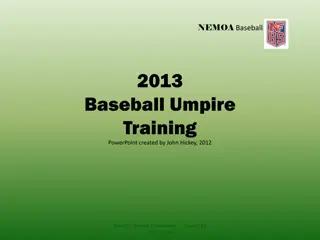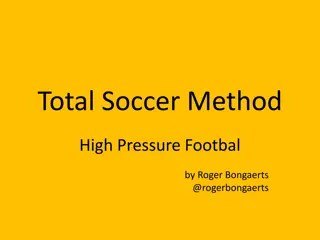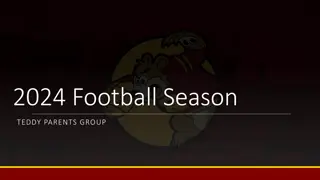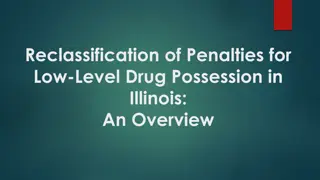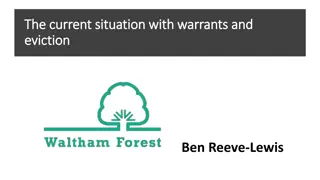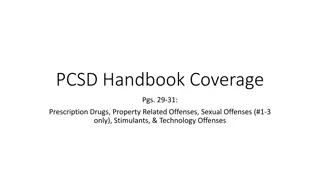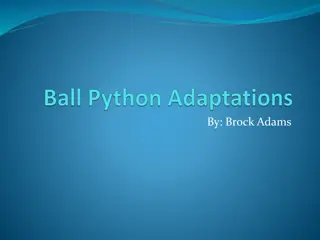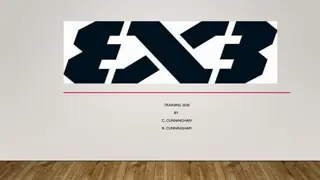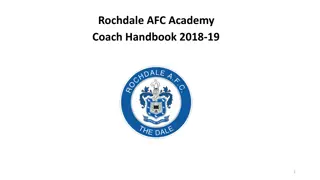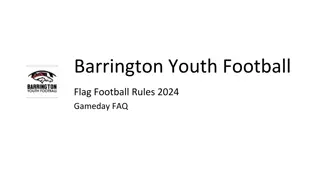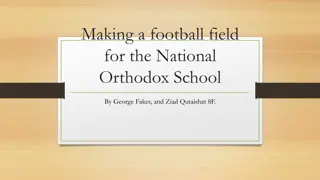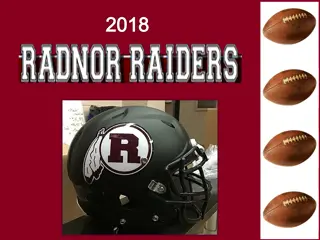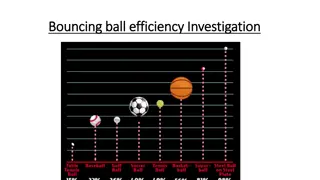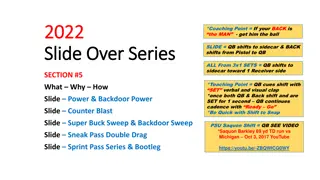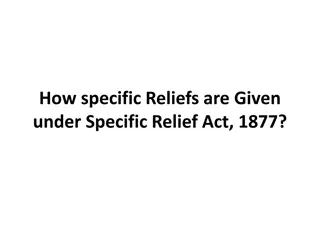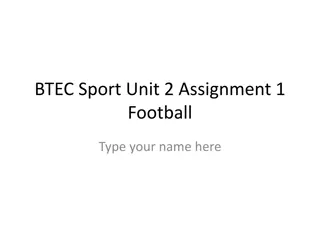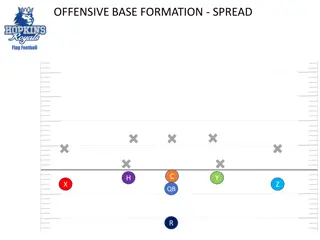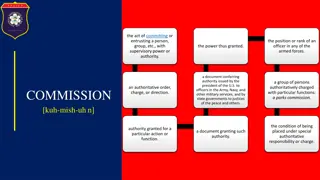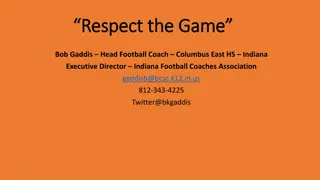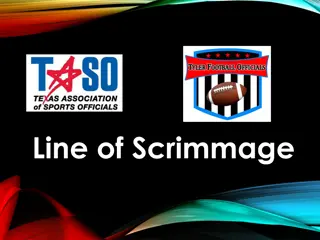Football Fundamentals Explained: Possession, Downs, Dead Ball, Kicks
Understanding the key concepts of football fundamentals including possession, downs, dead ball, and kicks. Learn about live ball possession, changes in possession, downs determination, defensive fouls, dead ball situations, and handling kicks during gameplay.
Download Presentation

Please find below an Image/Link to download the presentation.
The content on the website is provided AS IS for your information and personal use only. It may not be sold, licensed, or shared on other websites without obtaining consent from the author. Download presentation by click this link. If you encounter any issues during the download, it is possible that the publisher has removed the file from their server.
E N D
Presentation Transcript
Football Fundamentals I Possession A live ball is always in possession of a team. A live ball is in player possession or loose. A loose ball is in possession of the team whose player was last in possession. A player in possession of a live ball is a runner. A player cannot fumble before gaining possession. No foul causes loss of the ball. After a distance penalty, the ball belongs to the team which was in possession at the time of the foul according to applicable rules. Team possession may then change if a new series is awarded. Possession of a live ball in the opponent s end zone is always a touchdown.
Football Fundaments II - Downs A down begins when the ball becomes live and ends when it becomes dead. Whether the next down will be first is determined at the time the ball becomes dead and after considering the effect of any act, except a nonplayer or unsportsmanlike foul, which occurred during the down. If R is first to touch a scrimmage kick beyond the neutral zone, a new series will be awarded the team in possession at the end of the down, unless there was a foul before the kick and the penalty was accepted, or there was a double foul or there was an inadvertent whistle during the kick following the touching by R.
Football Fundamentals II - Downs continued The only defensive fouls which automatically cause a first down are roughing the kicker or placekick holder, roughing the passer, and roughing the snapper. . If the penalty is accepted for any live ball foul by either team during the last timed down of a period, the period must be extended by an untimed down, except for unsportsmanlike fouls, nonplayer fouls, fouls that specify loss of down, or fouls as specified in 3-3-4. No series can ever start on a down other than first.
Football Fundamentals III Dead Ball A game official s whistle seldom kills the ball. It is already dead by rule. No live-ball foul causes the ball to become dead. A dead ball may become live only by a legal snap or free kick. Catching is always preceded by touching of the ball; thus, if touching causes the ball to become dead, securing possession of the ball has no significance.
Football Fundamentals IV Kicks General A kick always ends as soon as any player secures possession. Any R player may catch or recover a kick and advance unless a valid or invalid fair-catch signal has been given by any R player. If a legal kick is caught in or beyond the neutral zone to R s goal line on a free kick and beyond the neutral zone to R s goal line on a scrimmage kick by a receiver after he has signaled for a fair catch, it is a fair catch, and the ball becomes dead as soon as it is caught. A fair catch may be made of any free kick which is in or beyond the neutral zone to R s goal line or a scrimmage kick which is beyond the neutral zone to R s goal. 5
Rule 2 Definitions of Playing Terms IV Kicks General Continued Any kick which is not a scoring attempt becomes dead when it breaks the plane of R s goal line No kick may legally be batted unless it is an attempt to block the kick in or behind the neutral zone, or if a grounded scrimmage kick which is beyond the neutral zone is batted by K toward his own goal line or caught by K when no player of R is in position to catch the ball. 7. First touching of a kick by K is always ignored if the penalty is accepted for foul during the down.
Football Fundamentals V Free Kicks The rules for the three free kicks are the same. Exception: a kickoff following a safety cannot score a field goal. Free-kick lines are always 10 yards apart. A free kick is not repeated unless a foul occurs prior to change of possession and the penalty acceptance requires a replay of the down or there was a double foul.
Football Fundamentals VI Scrimmage Kicks Touching of a low scrimmage kick by any player is ignored if it occurs in or behind the expanded neutral zone. Such touching may cause the ball to go out of bounds. A scrimmage kick recovered in or behind the neutral zone may be advanced by K or R.
Football Fundamentals VII Passes A player who is eligible at the start of the down remains eligible throughout the down. Offensive interior linemen are prohibited from advancing beyond the neutral zone only during a forward pass which crosses the neutral zone but may advance after the pass is in flight. A handed ball is not a pass. Any pass in flight may be batted in any direction by an eligible receiver unless it is a backward pass batted forward by the passing team. A forward-pass interference foul can occur only beyond the neutral zone.
Football Fundamentals VIII Blocking Blocking by either team is permissible, unless it is kick- catching interference or pass interference, a personal foul, or an illegal block.
Football Fundamentals IX Fouls No live-ball foul causes the covering official to sound his whistle immediately. A live-ball foul followed by a foul by the opponents after the ball becomes dead is not paired as a double foul. It is a foul to bat any loose ball which has touched the ground, except K may bat a grounded scrimmage kick which is beyond the neutral zone toward his own goal and may bat a scrimmage kick in flight beyond the neutral zone toward his own goal when no player of R is in position to catch the ball. A foul during a try is not paired with a dead-ball foul to make a double or multiple foul.
Football Fundamentals IX - Fouls Continued A double foul results only when both teams commit fouls, other than unsportsmanlike or nonplayer, during the same live-ball period or if team possession changed during the down and the foul by the team in final possession was prior to the change or if there were a change of possession and the team in final possession accepted the penalty for its opponent s foul. While it is possible to have several running plays during a down, with each one having its own basic spot for penalty enforcement, there can be only one loose-ball play during a down.
Football Fundamentals X Penalty Measurement The distance penalty for any foul may be declined. Penalties are either 5, 10, or 15 yards. Any live ball foul is penalized from the basic spot per 10-4 unless otherwise specified by rule. Penalty enforcement for any dead ball, nonplayer or unsportsmanlike foul is from the succeeding spot unless the foul occurs on a scoring play and the scoring team chooses enforcement on the kickoff per 8-2-2, 8-2-3, 8-2-4, or 8-2-5. The penalty for any one of the four illegal passes is a loss of 5 yards and the down is counted except for a forward pass following a change of team possession.
Football Fundamentals X Penalty Measurement Continued No penalty directly results in a safety, but if a distance penalty is enforced from behind the offender s goal line toward his end line, it is a safety. The penalty for a live-ball foul by the defensive team is administered from the basic spot, except when that spot is the end zone. The loss of down aspect of a penalty has no significance following a change of possession or if the line to gain is reached after enforcement.


